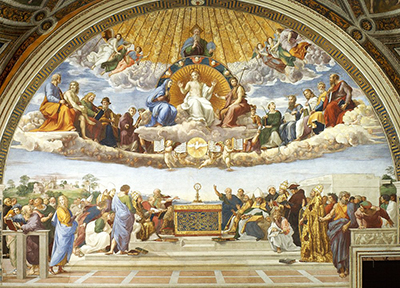For Raffaello Sanzio da Urbino – better known to English speakers as Raphael – the Disputation of the Holy Sacrament was the big break he had been hoping for.
After his years spent perfecting his art in Florence, this commission from the See of Rome was the start of a prolific and celebrated final stage in his career, and the first in a series of paintings that are arguably his most famous legacy.
The Disputation is one of four frescoes painted in the Stanza della Segnatura of Pope Julius II’s apartments. They are sometimes described as tondi – meaning simply a painting that fills a rounded area – and Raphael makes excellent use of this space to frame his image. Below the figures of Christ, God the Father and the gathered saints, the stage is set for the learned discussion of the title.
Appropriately enough for a study and library where the most important statements from the Vatican were signed, Raphael represents scenes of wisdom and erudition. On the facing tondo, he shows the great philosophers of Athens, seen by many Renaissance thinkers as the intellectual precursors of Christian ideas. A further link is found in the inclusion of a familiar figure in red, with a characteristic profile and a poet’s wreath: Dante, the seeker for enlightenment, meets and talks to many of the ‘virtuous pagans’ on his famous journey, and is guided by a Classical rather than Christian poet.
The busy composition found in this painting may remind some of the likes of Conversion of Saul by Michelangelo, The Coronation of the Virgin Altarpiece of St Mark by Sandro Botticelli and El Greco's Holy Trinity.
Among the figures, Raphael depicts the Fathers of the Early Church, including Saints Jerome and Augustine, known for the depth of their doctrinal thinking and forceful engagement in issues of faith. However, this is a disputation - not a dispute. Far from being a source of bitterness or division, the assembled company demonstrate a contemporary view: disputation is a way of praising God through the engagement and subtlety of their thought, and honouring the importance of divine truths.
Raphael brings a static-sounding subject to life with the vigour and technical mastery that characterise the high Renaissance: it’s there in the lighting of the young man on the right, almost leaning out of the painting; in the skilful foreshortening of the outstretched arm of the seated scribe by Pope Julius, and the brilliant perspectival treatment of the upper tier of saints. Figures turn, gesture, ponder, appeal, nod, or crane their necks to hear or see; they take notes or pore over books. To the left, a further side-argument seems to have developed. In other words, they look and behave like believable individuals – a lasting tribute to the spirit of the age.




